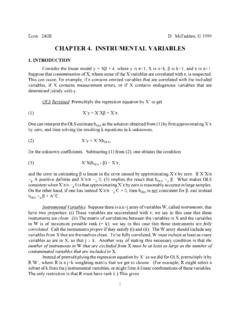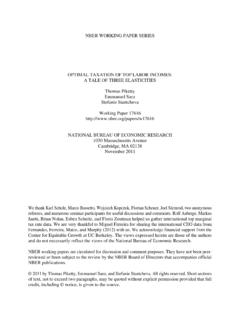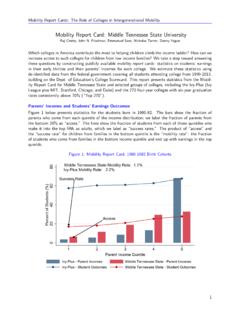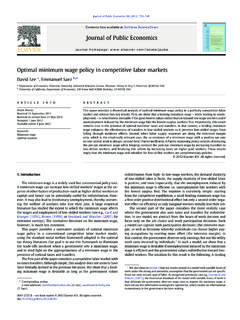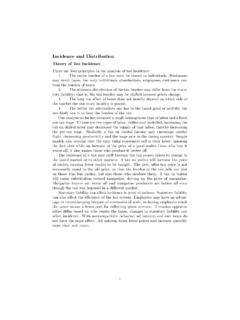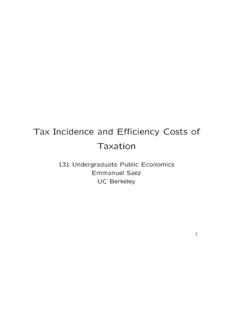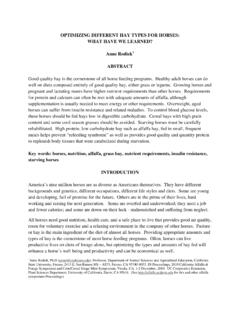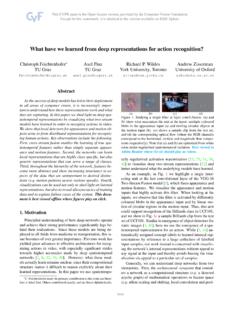Transcription of International Finance and Growth in Developing Countries ...
1 International Finance and Growth in Developing Countries : what have We learned ? Maurice Obstfeld* University of California, Berkeley March 2007 The years since 2002 have produced a surge in net capital flows from richer Countries to the Developing world. The International Monetary Fund estimates 2006 net private capital flows into Developing Countries at nearly $800 billion. A decade ago, an earlier surge of private capital to Developing Countries preceded a period of extreme financial turbulence, starting in Asia but spreading out to Russia and Latin America. The recent experience has been more tranquil, but against a particularly benign backdrop of strong economic Growth , low world interest rates, and elevated commodity prices. Would a possible unraveling of these favorable macro conditions expose the Developing world and possibly industrial-country financial markets to renewed crisis?
2 After the Asian debacle of 1997-98, prominent critics of financial globalization argued that its benefits were intangible and undocumented, whereas its risks were enormous and real. The years since the late 1990s have , however, seen concerted attempts, both at the national and supranational levels, to make the International financial environment more stable. Furthermore, the trend of financial evolution and opening in Developing Countries has continued. Accompanying the latter trend has been a seemingly successful bid, in many Developing Countries , to achieve stability in inflation and, to a degree, in the public finances. Once again, however, these achievements arguably have been facilitated by a generally benign global macroeconomy. * Draft prepared for the Commission on Growth and Development. I am grateful for research assistance from Jose Antonio Rodriguez-Lopez.
3 2 This paper reviews the benefits and costs of having financial globalization embrace the Developing Countries . Both theory and evidence are covered, with emphasis on the supporting institutional and policy reforms that seem most likely to result in net gains, and the progress Countries have made in achieving those reforms. I will argue that despite the meager direct evidence that Developing Countries gain from financial globalization, they should nonetheless proceed albeit cautiously, in an incremental manner. There is strong evidence that domestic financial development spurs Growth under the right conditions, and these conditions plus domestic financial development itself are likely to make capital inflows from abroad more productive. Furthermore, over the longer term, an internationally open financial system is likely to be more competitive, transparent, and efficient than a closed one.
4 Finally, extensive domestic financial development makes it much harder to police and enforce binding financial-account restrictions, especially as International trade in goods and services expands. I start by describing the trend of financial opening as well as recent capital flows to Developing Countries , comparing the circumstances of the recent surge with those of the one that ended a decade ago with the Asian crisis. Trends in financial integration and recent inflows to Developing Countries Researchers have devised both de jure and de facto quantitative measures of a country s integration with global capital The former types of measures often are based on information from the IMF s Annual Report on Exchange Arrangements and Exchange Restrictions (AREAER), a prominent example being the measures devised by 1 Stulz (2005) discusses the measures described below, as well as some others.
5 3 Figure 1: Quinn's de jure measure of capital account openness01020304050607080901001950 1955 1960 1965 1970 1975 1980 1985 1990 1995 OECDEast AsiaSouth America SubSaharan AfricaMENA Quinn (1997) and shown in Figure 1 for the period ending in 1999. For Developing Countries , these data indicate a trend of financial opening beginning in the late 1980s. There are well-known problems with the de jure measures, however; see Kose et al. (2006) for a thorough discussion. Aggregative de jure measures are quite subjective in some respects, for example. Moreover, capital controls that appear strict based on their statutory descriptions can, in reality, be quite porous. These limitations of the de jure measures motivate the consideration of various de facto measures of International financial integration. 4 Figure 2: As s e ts plus liabilitie s , 1970-2004 (ratio to group GDP) s s ets + Liabilities (H)A s s ets + Liabilities (E)A s s ets + Liabilities (D)A s s ets + Liabilities (G) One illuminating de facto measure is based on the data on total foreign assets and liabilities assembled by Lane and Milesi-Ferretti (2005); see Figure 2.
6 The data shown are disaggregated as characterizing high-income, industrialized Countries (H), middle-income emerging markets (E), generally poorer Developing Countries (D), and Gulf oil exporters (G). In all country groups (other than the Gulf group, which is a special case), the trend of de facto financial integration since the early 1990s is upward, most sharply in the high-income group, followed by the emerging markets. Recent years have seen a surge of net financial flows from richer Countries into the Developing world. Table 1 provides documentation of some of its characteristics, 5along with comparative data for the 1990s surge that preceded the Asian Three contrasts stand out: In the recent period the Developing world is in substantial current account surplus, whereas in the 1990s there was a net financial flow from rich to poorer Countries .
7 Second, the level of net inflow now is about double what it was then. Finally, one counterpart of the current account surplus cum financial inflow is a massive level of Table 1: Two surges in financial inflows to Developing Countries (USD billions) 1992-97 average 2003-06 average Current account balance all Developing Countries Net external financing all Developing Countries Increase in reserves all Developing Countries Current account balance Ex China, Russia, Middle East Net external financing Ex China, Russia, Middle East Increase in reserves Ex China, Russia, Middle East Source: IMF, WEO database (as of March 2007).
8 Average annual reserve accumulation in the last four years, as compared with the more moderate pace seen in the period 1992-97. Of course, there has also been an accelerated rate of acquisition of claims on the industrial Countries by Developing -country private residents. 2 Net external financing refers to the net resources foreign investors provide in order to Finance a country s current-account deficit, its net International reserve accumulation, and its residents own net 6 Recent data are dominated, however, by the substantial Chinese presence in International financial markets and by the commodity-price driven surpluses of the Russian Federation and Middle East. Stripping out those regions, we see that the level of financial inflows in recent years is ( Growth -adjusted) comparable to its level in the 1990s.
9 However, the two other differences remain. The Developing world, ex China, Russia, and the Middle East, is in approximate current account balance (the deficits of Central and Eastern Europe and Sub-Saharan Africa being matched by surpluses elsewhere). Furthermore, even outside of China and the oil surplus regions, reserve accumulation has been much more rapid recently. There are two implications for financial stability. First, Countries running current account surpluses do not have an external borrowing need that might suddenly be eliminated by capital-market pressures. Second, a high reserve level provides a precautionary cushion of ready liquidity that can be drawn on in a crisis. We may examine two other indicators of financial fragility. Average debt maturity levels, having fallen in the Developing world through the Asian crisis according to World Bank data, have since then lengthened somewhat.
10 See Figure 3. This development, taken alone, would tend to enhance stability by lowering the burden of a sudden capital flow reversal. The overall share of equity-like flows in net external financing (portfolio equity plus FDI) is little changed compared to the 1990s inflow experience, 58 percent in 2003-06 as against 59 percent in 1992-97. purchases of assets located abroad. The measure includes errors and omissions. 7 Figure 3: Average maturity by income level (years)914192429198019821984198619881990 1992199419961998200020022004 LICLMCMICUMC In both cases of capital inflow surge, low global interest rates have been an initial driving force. However, the level of nominal dollar interest rates (and real dollar rates) is lower now than in the 1990s, for reasons that remain under debate.
